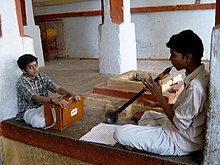
Back Shruti Catalan Shrutibox German Shruti box French सुरपेटी Hindi ശ്രുതിപ്പെട്ടി Malayalam Shruti box Portuguese
This article needs additional citations for verification. (December 2011) |




A shruti box (sruti box, shrutibox, srutibox or surpeti) is a musical instrument, originating from the Indian subcontinent, that traditionally works on a system of bellows. It is similar to a harmonium and is used to provide a drone in a practice session or concert of Indian classical music.[1] It is used as an accompaniment to other instruments and notably the flute. The shruti box is also used in classical singing. In classical singing, the shruti box is used to help tune the voice. The use of the shruti box has widened with the cross-cultural influences of world music and new-age music to provide a drone for many other instruments as well as vocalists and mantra singing.
Adjustable buttons allow tuning. Nowadays, electronic shruti boxes are commonly used, which are called shruthi pettige in Kannada, shruti petti in Tamil, Malayalam, and Telugu, and sur peti in Hindi.[2][3] Recent versions also allow for changes to be made in the tempo, and the notes such as Madhyamam, Nishadam to be played in place of the usual three notes (i.e., Lower shadjam, panchamam, and the upper shadjam).
- ^ Dr. Guy L. Beck (1 October 2007). "The Magic of Hindu Music: Exploring the religious, historical and social forces that shaped Hindu music and now propel it into the future". Hinduism Today. Retrieved 6 December 2011.
- ^ Children's Book of Music. DK Publishing. 2010. p. 33. ISBN 9780756676384.
- ^ Montes, Manuel. "Nóirín Ní Riain: Celtic Soul". Amazing Sounds. Retrieved 6 December 2011.
© MMXXIII Rich X Search. We shall prevail. All rights reserved. Rich X Search